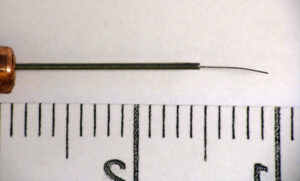Home » Supported Research » Ocular therapeutic delivery through real-time endoscopic b-scan oct-guided tools and robotic assistance
Ocular therapeutic delivery through real-time endoscopic b-scan oct-guided tools and robotic assistance
Title:
Ocular therapeutic delivery through real-time endoscopic b-scan oct-guided tools and robotic assistance
Project Number:
5R01EY028133-03
Contact PI/Project Leader:
Karen Joos
Award Organization:
National Institutes of Health
Abstract:
Therapeutic protocols using gene therapy or stem cells for treating ocular diseases are still in their infancy, but promise a paradigm shift in treating a variety of visual disorders. Functional cellular preservation is expected to reduce progression of vision impairment, thereby reducing suffering and economic burden. With an aging world population, developing efficient and cost-effective therapies for age-related ocular diseases have become critical. Although less common, inherited retinal disorders cause untreatable vision loss in the young with only supportive care available. New molecular therapeutic agents for these and other blinding diseases present a potential for sight preservation. However, robust translatable injection techniques to enable pre-clinical researchers and clinicians to visualize and accurately deliver therapies to the favored subretinal location are lacking. A safe and accurate subretinal injection procedure is hampered by lack of simultaneous real-time visualization of the cross-sectional retinal layers and the needle tip. Moreover, subretinal injections require extreme accuracy and steadiness beyond the physiological tremor of most surgeons. Due to these perception and technical challenges, the current injection technique may disrupt adjacent anatomical structures. In addition, agent or cells may be injected into the incorrect layer or reflux through the internal retinal hole into the vitreous cavity. Such complications may negatively affect potential vision preservation. The reliability and safety of delivering ocular therapeutics are ongoing FDA concerns, which may affect advancement of the dramatically increasing treatments with >80 Investigational New Drug applications in 2015. Our goal is to directly address the FDA concerns by offering solutions to the critical accuracy barriers of perception and maneuverability by using a novel concept of a direct approach for subretinal injections using needles equipped with B-scan optical coherence tomography (OCT)-guided visualization and by using robotic assistance with online segmentation for localized therapeutic delivery. Our main hypothesis is that the proposed approach with technological augmentation of surgeons’ visualization and manipulation skills for subretinal injections will enable a less invasive, more accurate, and safer therapeutic delivery procedure for ocular diseases. Aim I of our research includes the merging of novel B-scan OCT-guided needles with robotic assistance to achieve therapeutic delivery with minimal anatomical disruption. Aim II of our research includes testing our hypothesis by translating our systems to a preclinical porcine model to evaluate the role of visualization and maneuver augmentation in improving accuracy and time efficiency. This proposed work will develop efficacious OCT image-guided robotic-assisted surgical technologies and methods to enable the accurate delivery, of biologicals being discovered for future preventive, therapeutic and regenerative ocular treatments, with reduced procedural complexity and time.
